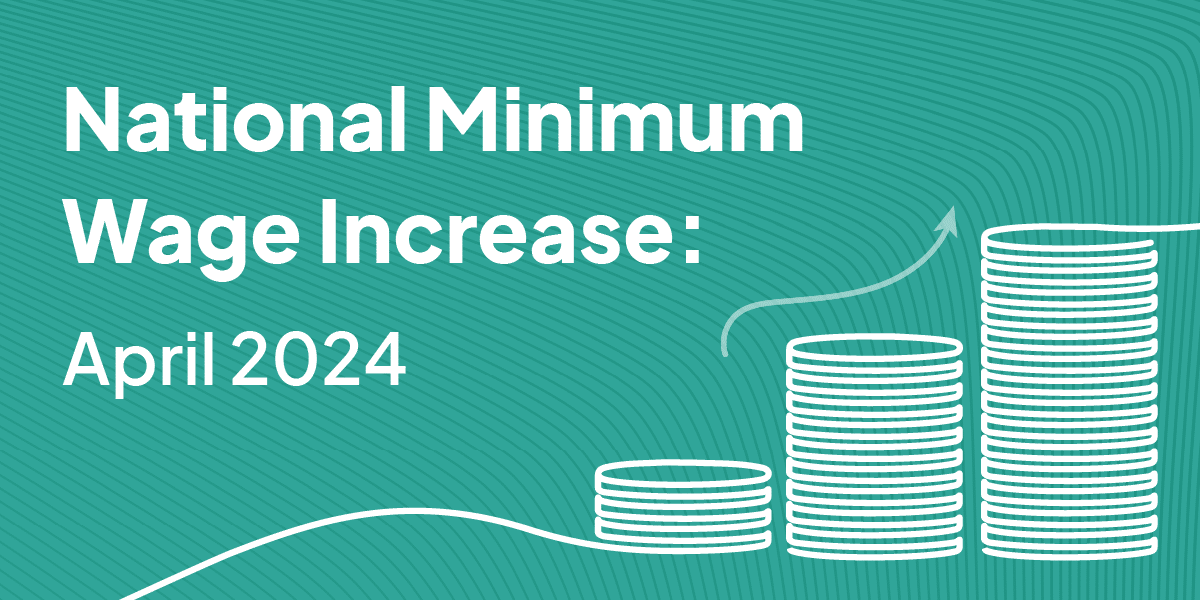
April 2024 will see the biggest rise in the national minimum wage (NMW) since it was introduced in 1998. 
How is the National Minimum Wage changing?
The NMW varies across different age groups, but it will rise across the board on April 1st. Our chart shows the increase and its net effect on labour costs:
Age |
Previous Minimum Wage (P/H) |
Minimum Wage from April 2024 (P/H) |
Total Increase Per Hour |
| 23+ | £10.42 | £11.44 | £1.02 |
| 21-22 | £10.18 | £11.44 | £1.26 |
| 18-20 | £7.49 | £8.60 | £1.11 |
| Under 18s | £5.28 | £6.40 | £1.12 |
| Apprentice Rate | £5.28 | £6.40 | £1.12 |
While annual increases to the NMW are standard and generally fall in-line with inflation, this is the first time that 21-22 year olds will have the same minimum wage as 23 year olds.
Three key ways NMW Increases impact employers
Labour costs
A rise in the minimum wage increases labour cost in industries such as hospitality, warehousing and social care where a majority of staff are paid the NMW. While the individual costs are small, the average worker in a restaurant, for example, works 28 hours per week. From April 1st, it will cost an additional £28.56 to pay an employee who is 23 or older; £35.28 for 21-22 year olds; and £31.08 for those aged 18-20. A single restaurant might employ up to 40 workers at this rate, and if we assume that at least half of them are paid the NMW, these increases could see weekly labour costs go up by between £571.20 and £705.60 – and as much as £36,691.20 over the course of a year.
Compliance risks
Employers must act quickly to ensure their April payroll adjusts to the new NMW. Failing to do so has serious financial and reputational consequences. Companies have been fined over £7 million in the last decade for failing to pay the NMW in the last decade, and all were named and shamed in the national media – significantly impacting their employer brands.
Volunteer entitlements
There are several groups of workers that are not entitled to the NMW, including freelancers, company directors and volunteers. However, the legal distinction between volunteers and employees is thin – and accidentally crossing it can leave employers with an obligation to pay taxes and provide volunteers with a minimum wage. Increases to the NMW only make this risk more serious, and employers must ensure that you know what is legally acceptable compensation for their voluntary workers to remain clearly categorised as volunteers.
How should employers adapt to NMW increases?
With labour costs about to increase, employers must take stock of their existing workforce strategy and figure out whether there are ways to offset the NMW rise. This could be achieved in three ways:
Pass on the costs
Many businesses have adapted to previous rises in NMW by slightly increasing their prices. This is more viable in industries like bars where the average price per unit is relatively low and companies tend to shift a large volume of stock, whereas industries such as care that have fewer customers and higher prices may struggle to increase costs in this way without losing customers.
Increase productivity
Many companies will be able to offset their labour cost increases purely through the positive impact of the NMW increases. One large-scale analysis of the impact of NMW increases suggests that they do not lead to reduced profit margins, but they do produce measurable increases to labour productivity. An uptick in productivity may, for example, be enough to enable warehouses to slightly reduce the number of hours their employees work each week without impacting their overall output – and thus help them avoid losing profit.
Demand management
The combination of data and flexible workers unlocks an alternative solution: reducing wastage in your labour budget. Many companies overstaff shifts because they don’t know how many workers they will need, but with the right demand management tools you can accurately predict how many workers you need and fill shifts on short notice. Companies that achieve this not only avoid the negative impact of increased NMW – they can afford to pay slightly higher rates. The result is a win-win: you maintain profitable labour margins, while workers get paid more than the new NMW.
How Indeed Flex is helping its clients navigate the changes
Indeed Flex will be automatically updating all Flexer rates on the 1st April 2024. The rates will reflect the government change as well as current industry standards to ensure the best chance of fulfilment and allow us to continue delivering you an engaged workforce. Please keep an eye on your inbox for April 2024 Rate Cards, to be released soon. Any questions? Please contact your Account Manager.








